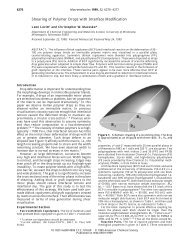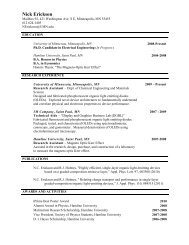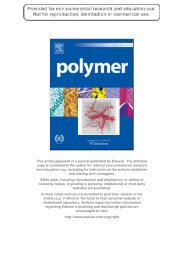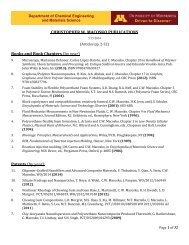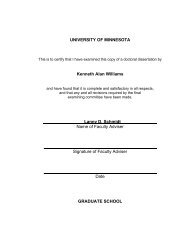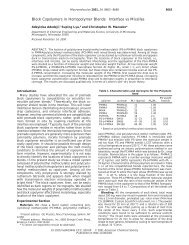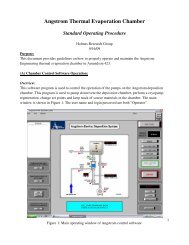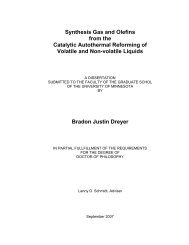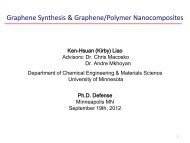Can Random Copolymers Serve as Effective Polymeric ...
Can Random Copolymers Serve as Effective Polymeric ...
Can Random Copolymers Serve as Effective Polymeric ...
You also want an ePaper? Increase the reach of your titles
YUMPU automatically turns print PDFs into web optimized ePapers that Google loves.
<strong>Can</strong> <strong>Random</strong> <strong>Copolymers</strong> <strong>Serve</strong> <strong>as</strong> <strong>Effective</strong> <strong>Polymeric</strong>Compatibilizers?M. S. LEE,* ,1 T. P. LODGE, 2 C. W. MACOSKO 11 Department of Chemical Engineering and Materials Science, University of Minnesota, 421 W<strong>as</strong>hington Ave.,Minneapolis, Minnesota 554552 Department of Chemistry, University of Minnesota, 207 Ple<strong>as</strong>ant St., S.E. Minneapolis, Minnesota 55455Received 17 April 1997; accepted 11 August 1997ABSTRACT: We investigate the compatibilizing performance of a random copolymer inthe melt state, using transmission electron microscopy. Blends of polystyrene (PS) andpoly(methyl methacrylate) (PMMA) are chosen <strong>as</strong> a model system, and a randomcopolymer of styrene and methyl methacrylate (SMMA) with 70 wt % styrene is used <strong>as</strong>a compatibilizer. From TEM photographs it is clear that SMMA moves to the interfacebetween PS and PMMA domains during melt mixing, and forms encapsulating layers.However, the characteristic size of the dispersed ph<strong>as</strong>e incre<strong>as</strong>es gradually with annealingtime for all blend systems studied. This demonstrates that the encapsulating layerof SMMA does not provide stability against static coalescence, which calls into questionthe effectiveness of random copolymers <strong>as</strong> practical compatibilizers. We interpret theencapsulation by random copolymers in terms of a simple model for ternary polymerblends. 1997 John Wiley & Sons, Inc. J Polym Sci B: Polym Phys 35: 2835–2842, 1997Keywords: polymer blends; random copolymer; compatibilizer; encapsulation; coalescenceINTRODUCTIONmethod for compatibilization of immiscible polymerblends. 8 There are many experimental andBlends of immiscible polymers often require the theoretical results that support this possibility.addition of a compatibilizer to improve the disperterfacialFirst, random copolymers can enhance the in-sion and adhesion of ph<strong>as</strong>es and to stabilize theadhesion between immiscible ph<strong>as</strong>es, 8–13morphology. Block or graft copolymers having the although the mechanism whereby a random co-same monomeric units <strong>as</strong> the blend components polymer layer strengthens the interface is stillhave been successfully used for this purpose. 1–4 controversial. 10,14 Second, random copolymers lo-Such compatibilizers can be introduced by adding cated at the interface can reduce the interfaciala premade copolymer, or by in situ reactive forma- tension between immiscible ph<strong>as</strong>es. For example,tion during melt processing. 5–7 However, these Balazs and co-workers recently examined the efcompatibilizersare typically expensive, and can fect of molecular architecture of potential compatcausea substantial viscosity incre<strong>as</strong>e during promers)on their compatibilizing performance usingibilizers (random, alternating, and diblock copoly-cessing.<strong>Random</strong> copolymers may offer an alternative the self-consistent mean field approach. 15 Theycalculated the extent of the interfacial tension reduction<strong>as</strong> a me<strong>as</strong>ure of the efficiency of the com-* On leave from Chonnam National University, Kwangju, patibilizers, and predicted that long random co-Koreapolymers are more effective than short diblocksCorrespondence to: T. P. Lodgewhen they compare random copolymers withJournal of Polymer Science: Part B: Polymer Physics, Vol. 35, 2835–2842 (1997) 1997 John Wiley & Sons, Inc. CCC 0887-6266/97/172835-08 diblocks of different molecular weight. However,28358Q46 / 8q46$$3012 10-20-97 05:06:51 polpa W: Poly Physics 9713012
2836 LEE, LODGE, AND MACOSKOat fixed molecular weight, diblock copolymers are were quenched in ice water. The sample code 70/more effective in reducing interfacial tension. 20/10 denotes 70% PS, 20% PMMA, and 10%Third, the spreading of random copolymers be- SMMA by weight. To investigate the melt stability,tween immiscible ph<strong>as</strong>es is thermodynamically<strong>as</strong>-blended samples were annealed in an ovenfavored. Winey and co-workers demonstrated that at 200C for a specified period of time and thenencapsulation by random copolymers can occur quenched in ice water. Specimens were wrappedduring drying of a solvated blend. 16in aluminum foil to prevent flow during annealing.It is not yet clear that random copolymers preferentiallyThe blend morphology of <strong>as</strong>-blended and aninglocate at the interfaces under melt mix- nealed samples w<strong>as</strong> characterized using a JEOLconditions, or whether they effectively stabilize1210 transmission electron microscope (TEM),the resultant morphology during annealing, operated at 120 kV. Sections of 70 nm thickness<strong>as</strong> is necessary for commercial application. Therefore,were microtomed at room temperature with amore data on the compatibilizing perfor- Reichert Ultracut S ultramicrotome. The sectionsmance of random copolymers in the melt state were stained for 15 min with the vapor of 0.5%are needed, because polymer blends are generally RuO 4 in water solution. The number (D n ) and volume-to-surfaceprepared by melt mixing. Furthermore, it is noteworthy(D VS ) average Waddel diameterthat the efficiency of compatibilizers can (the diameter for an equivalent sphere) of the disperseddepend on the blend preparation method. For example,ph<strong>as</strong>e were calculated from TEM photodependin melt compatibilization with premade graphs, averaging over 200 to 400 particles. Fordiblock copolymers, there appears to be an optimumthe c<strong>as</strong>e that SMMA forms encapsulating layersmolecular weight, 7 where<strong>as</strong> when blends between PS and PMMA domains, the layers wereare prepared by solution blending, compatibilizersincluded to calculate D n or D VS .with higher molecular weight are more effec-tive in reducing the dispersed ph<strong>as</strong>e size. 17In this study we investigate the compatibilizing RESULTS AND DISCUSSIONperformance of a random copolymer in the meltstate. Polystyrene (PS) and poly(methyl methac- As styrene is preferentially stained under the conditionsrylate) (PMMA) are chosen <strong>as</strong> model blend components,used in this study, 18 PS appears dark,and a random copolymer of styrene and SMMA gray, and PMMA white in bright-fieldmethyl methacrylate (SMMA) is used <strong>as</strong> the compatibilizer.TEM. This contr<strong>as</strong>t makes it possible to differentiwhetherThrough this study we will determine ate the SMMA ph<strong>as</strong>e in the blends. Figure 1random copolymers move to the interface shows TEM photographs of three <strong>as</strong>-blended sam-between matrix and dispersed ph<strong>as</strong>e during melt ples, where PS comprises the majority componentmixing and, if so, whether encapsulating layers at a constant concentration of 70 wt %. As seen inof random copolymers can stabilize blend mor- Figure 1(b) and (c), SMMA forms encapsulatingphology during melt annealing or not. Experimentallayers between the PS matrix and the PMMA par-answers to these two questions will be helpful ticles during melt mixing. The encapsulatingto determine whether random copolymers can be SMMA layer for the 70/20/10 blend is clearly seencommercially effective <strong>as</strong> compatibilizers.in the magnified TEM photograph inserted in Figure1(b). The ratio of PMMA to SMMA h<strong>as</strong> nodiscernible effect on the observed encapsulationEXPERIMENTALby SMMA, although for the 70/10/20 blend [Fig.1(c)] some pure SMMA domains exist. AlthoughThe source, molecular weight, and melt viscosity the blends were prepared by melt mixing ratherof the polymers used in this study are listed in than solution c<strong>as</strong>ting, the morphologies seen inTable I. Note that at the blending temperature Figure 1 are equivalent to those observed bythe ranking of viscosities is h SMMA ú h PS ú h PMMA . Winey and co-workers. 16 This suggests that encapsulationAll polymers have broad molecular weight distributions,by the random copolymer is indepen-and were provided in pellet form; they dent of the blend preparation method. Moreover,were used <strong>as</strong> received. Blend samples were preparedbecause SMMA h<strong>as</strong> the highest melt viscosity un-using a Haake Rheomix 600 batch mixer der the mixing conditions employed, we canconcludethat the driving force for the encapsulation,that is, the interfacial tension reduction by randomcopolymers, is strong enough for random co-operating at 210C for 20 min. The rotor speedw<strong>as</strong> 50 rpm, which corresponds to a maximumshear rate of 65 s 01 . After mixing, the samples8Q46 / 8q46$$3012 10-20-97 05:06:51 polpa W: Poly Physics 9713012
RANDOM COPOLYMERS AS EFFECTIVE POLYMERIC COMPATIBILIZERS 2837Table I.Polymers Used for This StudyPolymers Source M w (g/mol) PI a h b (Pa.s)PS Dow 200,000 1.8 894PMMA Polysciences, Inc. 100,000 1.9 660SMMA c Polysciences, Inc. 270,000 1.9 1383a Polydispersity index, me<strong>as</strong>ured using gel permeation chromatography.b Me<strong>as</strong>ured using a Rheometrics DSR rheometer at a shear rate of 50 s 01 and 210C.c 70 wt % styrene.polymers to move to the interfaces during melt the plot of (D n ) 3 vs. annealing time is almost themixing. A second observation from Figure 1 is the same within the experimental error.change in the size of dispersed ph<strong>as</strong>e with the Figure 4 shows the morphology change beforeaddition of SMMA. The dispersed ph<strong>as</strong>e size of and after melt annealing for a 20/70/10 blendthe 70/20/10 blend is significantly reduced com- with a PMMA matrix. As with blends with a PSpared to the 70/30/0 blend. As predicted by Balazsmatrix, SMMA encapsulates the minor ph<strong>as</strong>e andand co-workers, 15 this results from the in- dispersed ph<strong>as</strong>e coarsening is observed after an-terfacial tension reduction by SMMA layers locatednealing. Thus, the matrix type h<strong>as</strong> no significantat the interfaces. However, <strong>as</strong> seen in the effect on the encapsulation by random copolymers70/10/20 blend, SMMA used in excess does not and coarsening of encapsulated particles.contribute to further size reduction; rather, the Recently Macosko et al. attributed the role ofthickness of the SMMA shell incre<strong>as</strong>es.block copolymers in preventing static coalescenceIn accord with other experimental results re- to the steric stabilization mechanism of colloidalferred to in the Introduction, Figure 1 clearly particles, 7 i.e., the copolymer forms a brush atdemonstrates that random copolymers are poly- the interface. They proposed an el<strong>as</strong>tic repulsionmeric compatibilizers: SMMA moves to the interfacebetween approaching particles, caused by the retheduring melt mixing and contributes to reduce duction in the compatibilizer chain conformation.dispersed ph<strong>as</strong>e size. However, <strong>as</strong> noted in From the balance between van der Waals at-the Introduction, to be actually effective <strong>as</strong> a com- traction between approaching particles and thepatibilizer the layer located at the interface must entropic repulsion, they postulated that Ç 20%provide melt stability during other processing surface coverage by block copolymers is necessaryconditions, such <strong>as</strong> annealing. Figure 2, TEM photographsto impart static stability. In contr<strong>as</strong>t, the confor-of annealed blend samples, may provide mation of SMMA at the interface is very differentan answer. In all c<strong>as</strong>es, samples show that after from that of a block copolymer brush; in effect,60 min at 200C, the domain size h<strong>as</strong> incre<strong>as</strong>ed the SMMA chains may be considered <strong>as</strong> a separatesignificantly compared to that of the <strong>as</strong>-blendedph<strong>as</strong>e. Consequently, there is no repulsionsamples. This is similar to the coarsening process between encapsulated particles.observed for uncompatibilized polymer blends. 19,20 Figure 5 illustrates how the particles with en-Although the encapsulating layer of SMMA is well capsulating layers grow during annealing. Thedeveloped for 70/20/10 and 70/10/20 blends after photographs were obtained from a 70/10/20 blendannealing, it is clear that the layer does not pre- annealed for 60 min, and reorganized according tovent static coalescence. Considering that the the coalescence mechanism of immiscible polymerphysical properties of polymer blends depend crit- blends proposed by Chesters and others. 21–23 Asically on the size of dispersed ph<strong>as</strong>e <strong>as</strong> well <strong>as</strong> on seen in Figure 5, coalescence of the encapsulatedthe adhesion between the matrix and the dis- particles is two-step process: coalescence of encapsulatingpersed ph<strong>as</strong>e, the coarsening of encapsulated particlesparticles in the PMMA matrix, followedmay be a crucial disadvantage in commer- by coalescence of dispersed domains within thecial applications.encapsulating SMMA layer. The latter processThe change in the domain size with annealing might be slower than the first because the melttime is summarized in Figure 3(a). Upon annealing,viscosity of SMMA is higher than that of PS. It isthe particle size incre<strong>as</strong>es significantly, irre- clear that the encapsulating layer acts <strong>as</strong> a dis-spective of the blend composition. As shown in crete ph<strong>as</strong>e and does not provide stability againstFigure 3(b), the coarsening rate calculated from static coalescence. The force <strong>as</strong>sociated with the8Q46 / 8q46$$3012 10-20-97 05:06:51 polpa W: Poly Physics 9713012
2838 LEE, LODGE, AND MACOSKOparticle movement is sufficient to squeeze out theencapsulating SMMA layer when the encapsulatedPMMA particles collide. After a bridge betweentwo inner particles is formed by rupture ofFigure 2. TEM photographs of samples annealed at200C for 60 min: (a) 70/30/0 (D n Å 1.15; D VS Å 1.75);(b) 70/20/10 (D n Å 0.85; D VS Å 1.19); (c) 70/10/20 (D nÅ 0.87; D VS Å 1.18). The unit of D n and D VS is mm.Figure 1. TEM photographs of <strong>as</strong>-blended samples:(a) 70/30/0 (D n Å 0.80; D VS Å 1.03); (b) 70/20/10(D n Å 0.28; D VS Å 0.36); (c) 70/10/20 (D n Å 0.47; D VSÅ 0.56). The unit of D n and D VS is mm.the SMMA layer, a coalesced particle, which h<strong>as</strong>a well-developed encapsulating layer, is formed.The encapsulation by random copolymers canbe interpreted with a model proposed by Hobbsand co-workers for ternary polymer blends. 24 They8Q46 / 8q46$$3012 10-20-97 05:06:51 polpa W: Poly Physics 9713012
RANDOM COPOLYMERS AS EFFECTIVE POLYMERIC COMPATIBILIZERS 2839When both l 31 and l 13 are negative, we can expecttwo separate dispersed ph<strong>as</strong>es of 1 and 3. In otherwords, 3 moves to the interface and encapsulatesminor ph<strong>as</strong>e 1 or 2, when the sum of the interfacialtensions <strong>as</strong>sociated with 3 is smaller thanthe interfacial tension between the original blendcomponents. In mean-field theory g ij is proportionalto the square root of the Flory–Hugginsinteraction parameter x 25 ij <strong>as</strong>√g ij Å kT xijb 2 6(2)where b is the effective length per monomericunit, k is the Boltzmann constant, and T is temperature.Since for homopolymer/copolymer blendsx ij can be estimated from a binary interactionmodel, 26 we can estimate l ij for the PS/PMMA/Figure 3. (a) variation of the number-average particlediameter with annealing time; (b) plots of (D n ) 3 vs.annealing time. Slopes are proportional to coalescencerates.considered the spreading coefficient l ij , which determineswhether the third component should encapsulatethe minor ph<strong>as</strong>e or not. For the c<strong>as</strong>ethat a polymer, 3, is added to an immiscible polymerblend of components 1 and 2, l 31 is defined<strong>as</strong>l 31 Å g 12 0 [g 31 / g 32 ] (1)where g ij is the interfacial tension between i andj. Encapsulation of 3 onto 1 will occur if l 31 ú 0.Figure 4. TEM photographs of PS/PMMA/SMMA20/70/10 blends: (a) <strong>as</strong>-blended; (b) annealed at 200Cfor 60 min.8Q46 / 8q46$$3012 10-20-97 05:06:51 polpa W: Poly Physics 9713012
2840 LEE, LODGE, AND MACOSKOFigure 5. Coalescence of encapsulated particles: (a) approach and overlap of encapsulatinglayer; (b) deformation of dispersed particles and squeezing out the encapsulatinglayer; (c) rupture of the encapsulating layer; (d) m<strong>as</strong>s flow and coalescence. Note thatthese pictures do not represent a time series of two particular drops.SMMA system. We designate PS, PMMA, and The values of b PS and b PMMA obtained from neu-SMMA <strong>as</strong> 1, 2, and 3. tron scattering me<strong>as</strong>urements are 0.68 and 0.69For blends of PS, PMMA, and SMMA, x 13 and nm, respectively. 27 From eqs. (3), (4), and (5),x 23 are obtained from the binary interaction we can calculate l ij for a given matrix. The l ijmodel <strong>as</strong> follows:values calculated, and the corresponding morphologies,x 13 Å x 12 (1 0 f ) 2 (3) are given in Figure 6. The calculationpredicts that, except for the c<strong>as</strong>e of a random cox23 Å x 12 f 2 (4)polymer matrix, encapsulation by random copoly-mers is thermodynamically favored, regardless ofthe content and type of comonomer and matrix.where f is the volume fraction of styrene in This prediction is consistent with the TEM resultsSMMA. Assuming that the b values of PS, PMMA, of Figures 1 and 4. For the SMMA matrix, Wineyand SMMA are the same, we can approximate eq. et al. reported that two separate PS and PMMA(1) <strong>as</strong> domains are formed in the SMMA matrix and nol 31 É √ x 12 0 [ √ x 13 / √ x 23 ]encapsulation between PS and SMMA occurs. 16(5) Their observation is also in agreement with the8Q46 / 8q46$$3012 10-20-97 05:06:51 polpa W: Poly Physics 9713012
RANDOM COPOLYMERS AS EFFECTIVE POLYMERIC COMPATIBILIZERS 2841Figure 6. Spreading coefficients, l ij , for PS/PMMA/SMMA and possible morphologies for a given matrix.nealed at high temperature, the size of the encapsulatedparticles incre<strong>as</strong>es with annealing time.This means that the encapsulating layer of randomcopolymers does not provide stability againststatic coalescence. The amount of SMMA and thematrix type, PMMA or PS, have no effect on theencapsulation by SMMA and the coarsening processof encapsulating particles. It is not yet clearwhether the coarsening behavior observed in thisstudy is fatal for the physical properties of polymerblends compatibilized by random copolymersor not. To answer this question further experimentswill be necessary.The morphologies observed after annealing areequivalent to those seen after long drying of <strong>as</strong>olvated blend. 16 Moreover, the same morphologyw<strong>as</strong> also seen in <strong>as</strong>-blended samples. It is clearthat encapsulation by SMMA is thermodynami-cally favored and a driving force effectively acts tolocate SMMA at a preferred position, the interfacebetween PS and PMMA ph<strong>as</strong>es. The driving forcefor encapsulation is apparently the reduction ofinterfacial tension caused by the addition of ran-dom copolymers. From spreading coefficients cal-culated from Helfand and Tagami theory and abinary interaction model we can predict that theencapsulation by random copolymers is thermo-dynamically favored. Also, the encapsulation byrandom copolymers is independent of copolymertype and comonomer composition. However, to establishwhether this result is a general rule willrequire further work.prediction of Figure 6. Further evidence for theencapsulation by random copolymers may befound for polypropylene (PP)/polyethylene (PE)/ethylene–propylene rubber (EPR) blends, whereEPR encapsulate the minor PE ph<strong>as</strong>e. 28The encapsulation by random copolymers maybe extended to other blend systems. For misciblepolymers, the interfacial tension is effectivelyzero. Therefore, it is possible to prepare polymerblends with encapsulation by random copolymerwhen we replace one or both of blend componentswith corresponding miscible components. Becausepolycarbonate (PC) is partially miscible withPMMA, and poly(phenylene oxide) (PPO) is completelymiscible with PS, 3,29 PS/PC/SMMA, PPO/PMMA/SMMA, and PPO/PC/SMMA blends arecandidates for encapsulation. From TEM photographswe have found that in all c<strong>as</strong>es, SMMAmoves to the interface during melt mixing and This work w<strong>as</strong> supported in part by the Center for Informsan encapsulating layer.terfacial Engineering, an NSF-sponsored EngineeringResearch Center at the University of Minnesota. M.S.L.thanks the Korea Science and Engineering FoundationSUMMARY(KOSEF) and Chonnam National University (CNU)for fellowship support.We investigate whether random copolymers canact <strong>as</strong> effective compatibilizers for blends preparedby melt mixing. Similar to previous experimentaland theoretical studies, the possibility ofREFERENCES AND NOTESrandom copolymers acting <strong>as</strong> polymeric compatiandS. Newman, Eds., Academic Press, New York,1. D. R. Paul, in Polymer Blends, Vol. 2, D. R. Paulbilizers can be seen from TEM photographs of <strong>as</strong>blendedsamples. SMMA moves to the interfaces 1978.between PS and PMMA domains during melt mix-2. L. A. Utracki, Polymer Alloys and Blends, HanserPublishers, Munich, 1989.ing and forms encapsulating layers. As a result,3. L. A. Utracki, Ed., Encyclopaedic Dictionary ofthe size of the dispersed ph<strong>as</strong>e is significantly re-Commercial Polymer Blends, ChemTec Publishing,duced. When SMMA is used in excess, separate Toronto, 1994.domains of pure SMMA are formed. This is analo- 4. S. Datta and D. Lohse, <strong>Polymeric</strong> Compatibilizers,gous to micelle formation of block copolymers in Hanser Publishers, Munich, 1996.the c<strong>as</strong>e of compatibilization by premade block 5. C. D. Park, W. H. Jo, and M. S. Lee, Polymer, 37,copolymers. However, when the blends are an- 3055 (1996).8Q46 / 8q46$$3012 10-20-97 05:06:51 polpa W: Poly Physics 9713012
2842 LEE, LODGE, AND MACOSKO6. P. Guegan, C. W. Macosko, T. Ishizona, T. Hirao, 17. S. Thom<strong>as</strong> and R. E. Prud’homme, Polymer, 33,S. Nakayama, Macromolecules, 27, 4993 (1994).4260 (1992).7. C. W. Macosko, P. Guegan, A. K. Khandpur, A. Na- 18. J. S. Trent, J. I. Scheinbeim, and R. R. Couchman,kayama, P. Marechal, and T. Inoue, Macromole- Macromolecules, 16, 589 (1983).cules, 29, 5590 (1996).19. U. Sundararaj and C. W. Macosko, Macromole-8. See, for example, R.-J. Roe and D. Rigby, Adv. cules, 28, 2647 (1995).Polym. Sci., 82, 105 (1987).20. B. Christ and A. K. Nesarikar, Macromolecules, 28,9. H. R. Brown, K. Char, V. R. Deline, and P. F. 890 (1995).Green, Macromolecules, 26, 4155 (1993).21. A. K. Chesters, Trans. Inst. Chem. Eng., 69, 25910. C. A. Dai, B. J. Dair, K. H. Dai, C. K. Ober, E. J.(1991).Kramer, C. Y. Hui, and L. W. Jelinski, Phys. Rev.22. A. Saboni, C. Gourdon, and A. K. Chesters, J. Col-Lett., 73, 2472 (1994).loid Interface Sci., 175, 27 (1995).23. I. Fortelny and A. Zivny, Polymer, 36, 4113 (1995).11. K. Cho, T. O. Ahn, H. S. Ryu, and K. H. Seo, Poly-24. S. Y. Hobbs, M. E. J. Dekkers, and V. H. Watkins,mer, 37, 4849 (1996).Polymer, 29, 1598 (1988).12. R. Kul<strong>as</strong>ekere, H. Kaiser, J. F. Ankner, T. P. Rus-25. E. Helfand and Y. Tagami, J. Polym. Sci., Lett., 9,sell, H. R. Brown, C. J. Hawker, and A. M. Mayes,741 (1971).Macromolecules, 29, 5493 (1996).26. G. ten Brinke, F. E. Kar<strong>as</strong>z, and W. J. MacKnight,13. M. Sikka, N. N. Pellagrini, E. A. Schmitt, and K. I. Macromolecules, 16, 1827 (1983).Winey, Macromolecules, 30, 445 (1997).27. D. G. H. Ballard, G. D. Wignall, and J. Schelten,14. S. T. Milner and G. H. Fredrickson, Macromole- Eur. Polym. J., 9, 965 (1973).cules, 28, 7953 (1995).28. F. C. Stehling, T. Huff, C. S. Speed, and G. Wissler,15. Y. Lyatskaya, D. Gersappe, N. A. Gross, and A. C. J. Appl. Polym. Sci., 26, 2693 (1981).Balazs, J. Phys. Chem., 100, 1449 (1996).29. T. Kyu, J. M. Saldanha, and M. J. Kiesel, in Two-16. K. I. Winey, M. L. Berba, and M. E. Galvin, Macro- Ph<strong>as</strong>e Polymer Systems, L. A. Utracki, Ed., Hansermolecules, 29, 2868 (1996).Publishers, Munich, 1991.8Q46 / 8q46$$3012 10-20-97 05:06:51 polpa W: Poly Physics 9713012



